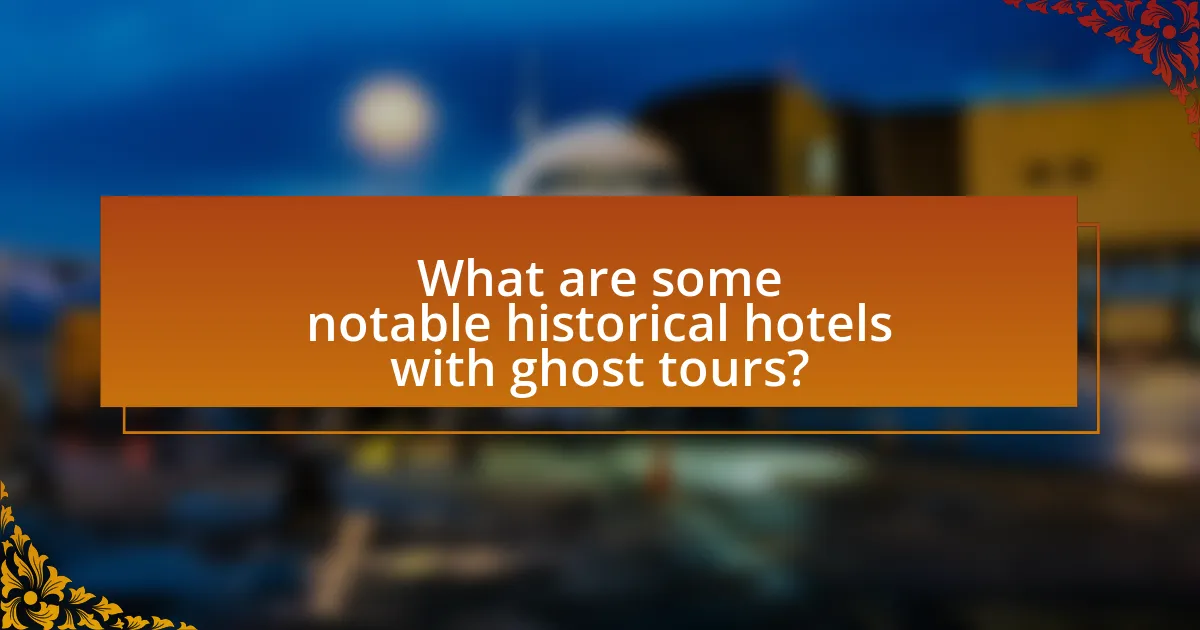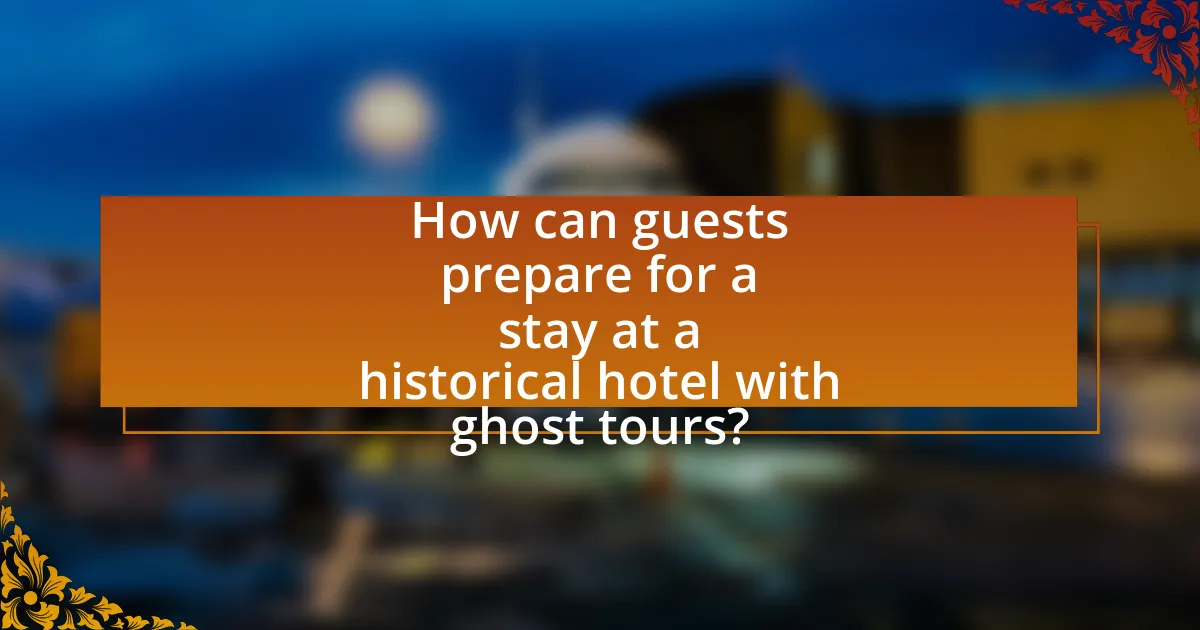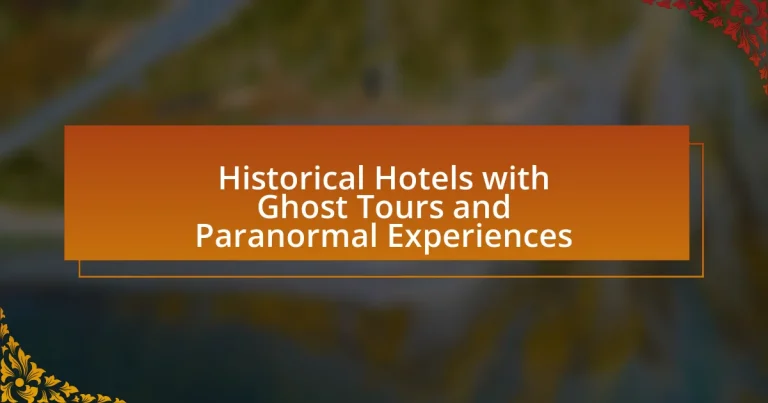Historical hotels with ghost tours and paranormal experiences are accommodations that allow guests to explore their haunted histories through guided tours focused on reported supernatural occurrences. These hotels, often rich in history and architectural significance, attract visitors interested in both their past and the thrill of the paranormal. The article examines how these hotels gain notoriety for ghost tours, the criteria that define them as historical, and the types of paranormal experiences guests can expect. It also discusses the popularity of ghost tours, notable hotels known for such experiences, and tips for guests to enhance their stay and engagement with the hotel’s history.

What are Historical Hotels with Ghost Tours and Paranormal Experiences?
Historical hotels with ghost tours and paranormal experiences are accommodations that offer guests the opportunity to explore their haunted histories through guided tours and activities focused on reported supernatural occurrences. These hotels often have rich backstories, with many dating back several centuries, and are located in areas known for their historical significance. For example, the Stanley Hotel in Colorado is famous for its connection to Stephen King’s “The Shining” and offers ghost tours highlighting its eerie past. Such experiences typically include storytelling about past guests, unexplained phenomena, and sometimes even overnight stays in allegedly haunted rooms, providing a unique blend of history and the paranormal.
How do historical hotels become known for ghost tours?
Historical hotels become known for ghost tours primarily through their rich histories and reported paranormal activities. These hotels often have intriguing backstories involving significant events, famous guests, or tragic occurrences that attract interest. For instance, hotels like the Stanley Hotel in Colorado gained notoriety due to its association with Stephen King’s “The Shining,” leading to a surge in ghost tour popularity. Additionally, many historical hotels promote their haunted reputations through marketing strategies, including ghost-themed events and collaborations with local paranormal investigators, which further solidifies their status as ghost tour destinations.
What criteria define a hotel as ‘historical’?
A hotel is defined as ‘historical’ based on its age, architectural significance, and association with notable events or figures. Specifically, a hotel typically qualifies as historical if it is at least 50 years old, features distinctive architectural styles representative of its era, and has documented connections to significant historical events or personalities. For instance, the National Register of Historic Places in the United States includes hotels that meet these criteria, emphasizing their importance in preserving cultural heritage.
How do ghost stories contribute to a hotel’s reputation?
Ghost stories significantly enhance a hotel’s reputation by attracting guests seeking unique experiences. These narratives create an aura of intrigue and mystery, often leading to increased media coverage and word-of-mouth promotion. For instance, hotels like the Stanley Hotel in Colorado have capitalized on their ghostly tales, resulting in a surge of visitors interested in paranormal activities. This phenomenon is supported by research indicating that 37% of travelers are drawn to hotels with a haunted reputation, demonstrating that ghost stories can effectively boost occupancy rates and overall brand appeal.
Why are ghost tours popular among visitors?
Ghost tours are popular among visitors because they offer a unique blend of entertainment, history, and the thrill of the supernatural. These tours often take place in historical locations, allowing participants to learn about the past while experiencing stories of hauntings and paranormal activity. For instance, many ghost tours highlight significant events or figures associated with the sites, enhancing the educational aspect. Additionally, a survey by the American Ghost Tour Association found that 70% of participants are drawn to the excitement and curiosity surrounding ghost stories, making these tours an appealing choice for those seeking both adventure and cultural enrichment.
What experiences do guests seek during ghost tours?
Guests seek immersive and thrilling experiences during ghost tours, often looking for a combination of historical storytelling, paranormal encounters, and a sense of adventure. These tours typically provide insights into local legends, hauntings, and the history of the locations visited, enhancing the overall experience with factual narratives. Research indicates that participants are drawn to the emotional engagement and the adrenaline rush associated with potential ghost sightings, as well as the opportunity to explore the unknown in a guided setting.
How do ghost tours enhance the historical significance of hotels?
Ghost tours enhance the historical significance of hotels by providing immersive experiences that connect guests with the hotel’s past. These tours often highlight real historical events, notable figures, and architectural details, thereby enriching the narrative of the hotel. For instance, hotels like the Stanley Hotel in Colorado, known for its ghost stories, attract visitors interested in both its haunted reputation and its role in American history, particularly in relation to Stephen King’s “The Shining.” This dual focus on history and the supernatural fosters a deeper appreciation for the hotel’s heritage, making it a focal point for cultural tourism.
What types of paranormal experiences can guests expect?
Guests can expect a variety of paranormal experiences, including ghost sightings, unexplained noises, and temperature fluctuations. Historical hotels often have rich backstories involving past residents or events, which contribute to these phenomena. For instance, many guests report seeing apparitions or feeling a presence in specific rooms, supported by documented accounts of hauntings in locations like the Stanley Hotel in Colorado, known for its ghost tours and eerie atmosphere. Additionally, guests may experience objects moving unexpectedly or hear disembodied voices, which are common claims in hotels with a history of paranormal activity.
What are common types of paranormal activities reported in hotels?
Common types of paranormal activities reported in hotels include ghost sightings, unexplained noises, and objects moving on their own. Ghost sightings often involve apparitions or figures that guests claim to see in their rooms or hallways, particularly in historic hotels known for their haunted reputations. Unexplained noises, such as footsteps, whispers, or doors opening and closing without cause, are frequently reported by guests, contributing to the eerie atmosphere. Additionally, guests have reported instances of objects being displaced or moved, which cannot be attributed to any logical explanation. These activities are often documented in guest reviews and paranormal investigations, reinforcing the belief in the supernatural presence within these establishments.
How do guests typically react to these experiences?
Guests typically react to historical hotels with ghost tours and paranormal experiences with a mix of excitement and skepticism. Many guests express thrill and curiosity, often sharing positive reviews about the immersive storytelling and unique atmosphere that these experiences provide. According to a survey conducted by the American Hotel and Lodging Educational Institute, 65% of participants reported that they found ghost tours to be an engaging way to learn about the history of the hotel and its surroundings. Additionally, guests often share their personal encounters or feelings of unease, which can enhance the overall experience for others. This combination of emotional engagement and historical intrigue contributes to a generally favorable reaction among guests.

What are some notable historical hotels with ghost tours?
Some notable historical hotels with ghost tours include the Stanley Hotel in Estes Park, Colorado, known for its connection to Stephen King’s “The Shining,” and the Hotel Del Coronado in California, famous for its ghostly sightings of a woman in a white dress. The Myrtles Plantation in Louisiana is also renowned for its haunted history, claiming to be one of America’s most haunted homes. Each of these hotels offers guided ghost tours that explore their eerie pasts and reported paranormal activities, providing guests with a unique blend of history and the supernatural.
Which hotels are renowned for their ghost tours?
The Stanley Hotel in Estes Park, Colorado, is renowned for its ghost tours, attracting visitors interested in paranormal experiences. This hotel, famous for inspiring Stephen King’s “The Shining,” offers guided tours that explore its haunted history, including sightings of ghostly apparitions and unexplained phenomena. Another notable hotel is the Hotel Del Coronado in California, known for its ghostly resident, Kate Morgan, who is said to haunt the premises. These hotels provide immersive experiences that highlight their historical significance and reported supernatural occurrences.
What unique features do these hotels offer?
These historical hotels offer unique features such as guided ghost tours, which provide guests with insights into the hotel’s haunted history and paranormal activities. For example, the Stanley Hotel in Colorado is famous for its ghost tours that explore the eerie tales associated with its past, including sightings of former guests. Additionally, many of these hotels incorporate themed rooms that reflect their historical significance, enhancing the immersive experience for visitors. The combination of rich history and paranormal intrigue attracts guests seeking both adventure and a glimpse into the past, making these hotels distinct in the hospitality industry.
How do the histories of these hotels contribute to their ghost stories?
The histories of hotels significantly contribute to their ghost stories by providing a rich backdrop of events, tragedies, and notable figures that can lead to hauntings. For instance, hotels with a history of violent incidents, such as murders or accidents, often report ghostly encounters linked to those events, as seen in the case of the Stanley Hotel, where the tragic past of its original owner is said to influence its paranormal activity. Additionally, the presence of historical figures, such as celebrities or influential personalities who may have stayed at these hotels, adds to the lore, as guests often report sightings or experiences related to these individuals. This connection between historical events and ghostly tales creates a narrative that enhances the allure of the hotels, making them popular destinations for those interested in the paranormal.
What regions are famous for historical hotels with ghost tours?
Regions famous for historical hotels with ghost tours include New Orleans, Louisiana; Savannah, Georgia; and San Antonio, Texas. New Orleans is renowned for its rich history and haunted locations, such as the Hotel Monteleone, which offers ghost tours highlighting its spectral residents. Savannah, known for its well-preserved architecture and eerie tales, features the Marshall House, where guests can explore its ghostly past through organized tours. San Antonio’s historic Menger Hotel, adjacent to the Alamo, is also famous for its ghost tours that recount the hotel’s haunted history. These regions are recognized for their blend of historical significance and paranormal experiences, attracting both history buffs and ghost enthusiasts.
How does the location influence the ghost stories associated with hotels?
The location significantly influences the ghost stories associated with hotels by providing historical context and cultural significance that shape the narratives. Hotels situated in areas with rich histories, such as battlefields or sites of tragic events, often have ghost stories linked to those events, as seen in the Stanley Hotel in Colorado, which is known for its ties to Stephen King and its haunted reputation stemming from its historical past. Additionally, geographical features, such as proximity to old cemeteries or landmarks, can enhance the eerie atmosphere, contributing to the development of local legends and ghostly encounters. For instance, the Myrtles Plantation in Louisiana, located near a former slave plantation, is steeped in ghost stories that reflect the region’s complex history. Thus, the interplay between location and historical events creates a fertile ground for ghost stories in hotels.
What cultural factors play a role in the popularity of ghost tours in these regions?
Cultural factors that contribute to the popularity of ghost tours in regions with historical hotels include local folklore, historical significance, and community engagement with the supernatural. Local folklore often includes tales of hauntings and spirits, which attract tourists seeking authentic experiences. Historical significance enhances the allure, as many ghost tours are based on real events or notable figures, providing a narrative that connects visitors to the past. Additionally, community engagement, such as festivals or events centered around ghost stories, fosters a cultural environment that embraces the paranormal, making ghost tours a popular activity. For instance, cities like Savannah, Georgia, known for their rich history and ghost stories, see a significant influx of tourists drawn by these cultural narratives.
What are the most famous ghost tours available at these hotels?
The most famous ghost tours available at historical hotels include the Stanley Hotel’s Ghost Tour in Estes Park, Colorado, known for its connection to Stephen King’s “The Shining,” and the Myrtles Plantation Ghost Tour in St. Francisville, Louisiana, which is reputed to be one of America’s most haunted homes. The Stanley Hotel offers a guided exploration of its haunted history, while the Myrtles Plantation tour highlights ghost sightings and the plantation’s dark past, including tales of former slaves and tragic events. Both tours are well-documented and attract numerous visitors seeking paranormal experiences.
What themes are commonly explored in these ghost tours?
Common themes explored in ghost tours include local history, hauntings, and folklore. These tours often highlight significant historical events associated with the locations, such as battles, tragedies, or notable figures who may have experienced untimely deaths. Additionally, they delve into the folklore surrounding the area, sharing stories of spirits and supernatural occurrences that have been passed down through generations. For instance, many ghost tours in historical hotels emphasize the unique architecture and past occupants, providing context that enhances the eerie narratives. This combination of history and storytelling creates a compelling experience for participants, allowing them to engage with the past in a hauntingly memorable way.
How do tour guides enhance the ghost tour experience?
Tour guides enhance the ghost tour experience by providing engaging narratives that blend historical facts with local legends. Their storytelling skills create an immersive atmosphere, allowing participants to connect emotionally with the haunted locations. For instance, a tour guide might recount the tragic history of a hotel, such as the infamous events that led to reported hauntings, thereby enriching the experience with context and depth. Additionally, guides often share personal anecdotes or testimonials from previous guests, which can heighten the sense of authenticity and intrigue. This combination of factual information and captivating storytelling significantly elevates the overall ghost tour experience.

How can guests prepare for a stay at a historical hotel with ghost tours?
Guests can prepare for a stay at a historical hotel with ghost tours by researching the hotel’s history and its reported hauntings. Understanding the background of the hotel enhances the experience, as many historical hotels have unique stories and legends associated with them. Additionally, guests should pack comfortable clothing and shoes suitable for walking during the ghost tours, which often involve exploring the hotel and its surroundings. It is also advisable to bring a flashlight, as some tours may take place in dimly lit areas. Finally, guests should check the schedule for ghost tours in advance and consider booking tickets early, as these tours can be popular and may sell out quickly.
What should guests know before booking a stay?
Guests should know that historical hotels offering ghost tours and paranormal experiences often have unique policies and features that differ from standard accommodations. These hotels may have age restrictions for tours, specific hours for ghost-related activities, and may require advance booking due to limited availability. Additionally, guests should be aware that the ambiance and decor may reflect the hotel’s historical significance, which can enhance the overall experience but may also include elements that some might find unsettling. Understanding these aspects can help guests make informed decisions and fully enjoy their stay.
How can guests choose the right hotel for their ghost tour experience?
Guests can choose the right hotel for their ghost tour experience by researching hotels known for their historical significance and reported paranormal activity. Hotels like the Stanley Hotel in Colorado and the Myrtles Plantation in Louisiana are renowned for their ghost tours and rich histories, providing guests with immersive experiences. Additionally, reading reviews and testimonials from previous guests can offer insights into the authenticity of the ghost tours and the overall atmosphere of the hotel.
What are the best times to visit for ghost tours?
The best times to visit for ghost tours are during the fall months, particularly October, when Halloween festivities heighten interest in paranormal activities. This period often features special events and themed tours that attract larger crowds, enhancing the overall experience. Additionally, evening hours, especially after sunset, are preferred for ghost tours as they create a more atmospheric setting conducive to ghostly encounters. Historical data shows that many ghost tours report increased participation and engagement during these times, making them ideal for enthusiasts seeking thrilling experiences.
What tips can enhance the ghost tour experience?
To enhance the ghost tour experience, participants should engage actively with the tour guide and the environment. Engaging with the guide allows for deeper insights into the history and stories behind the locations visited, as guides often share unique anecdotes and local legends that enrich the experience. Additionally, being observant and open-minded can lead to a more immersive experience, as many ghost tours include interactive elements or encourage participants to share their own experiences. Historical context is crucial; understanding the background of the locations can heighten the emotional impact of the stories told. For instance, knowing that a hotel was built in the 1800s and has a history of reported hauntings can make the experience more compelling. Lastly, visiting during twilight or nighttime can enhance the atmosphere, as many ghost tours are designed to take advantage of the eerie ambiance that darkness provides.
How can guests engage with the history of the hotel during their stay?
Guests can engage with the history of the hotel during their stay by participating in guided historical tours that highlight significant events and figures associated with the property. These tours often include storytelling elements that reveal the hotel’s past, including its architectural features and any notable guests who have stayed there. For example, many historical hotels offer ghost tours that explore local legends and paranormal activities, providing a unique perspective on the hotel’s history. Engaging with artifacts displayed in the hotel, such as photographs and memorabilia, further enhances the experience by connecting guests to the hotel’s legacy.
What should guests bring to make the most of their ghost tour experience?
Guests should bring a flashlight to enhance their visibility during the ghost tour, especially in dimly lit areas. A flashlight allows guests to navigate safely and observe details that may be missed in the dark. Additionally, bringing a camera can help capture any intriguing sights or experiences, as many ghost tours take place in historically significant locations known for paranormal activity. Comfortable walking shoes are also essential, as tours often involve walking for extended periods on uneven terrain. Finally, a notebook can be useful for jotting down thoughts or experiences, which can enhance the overall engagement with the tour.


